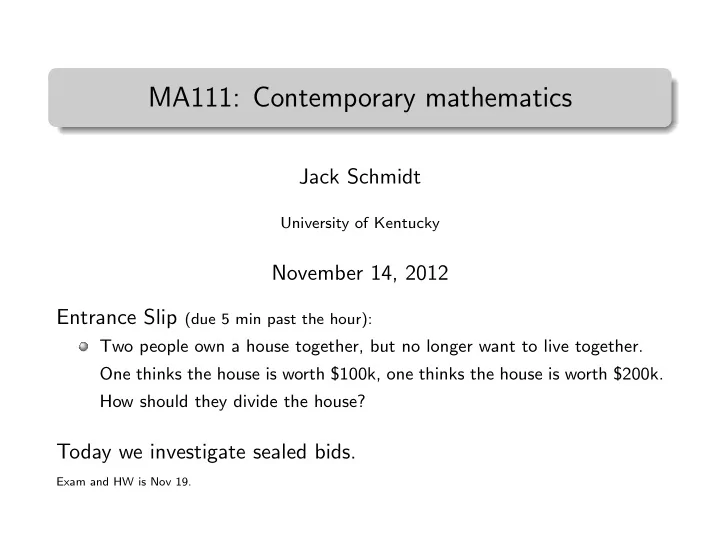

. MA111: Contemporary mathematics . Jack Schmidt University of Kentucky November 14, 2012 Entrance Slip (due 5 min past the hour): Two people own a house together, but no longer want to live together. One thinks the house is worth $100k, one thinks the house is worth $200k. How should they divide the house? Today we investigate sealed bids. Exam and HW is Nov 19.
Context: How to compensate someone for their fair share Not all loot can be divided. Half a diamond, half a car. Instead, one of the half-owners sells to the other half-owner. What is the fair price? Normal stuff does not work well, because someone MUST sell. “Market price” does not work well, because our goal is for the owners not to feel cheated, and the market does not care about their feelings.
Activity: Sealed bids Sealed bids is very simple: we let the owners set the price One person buys the loot from the group (as a whole) for his price Each member of the group then receives his fair price as a seller But there is good news! You tell me what the good news is. If we imagine the guy who gets the loot, A, is buying it from the other owners then the purchase must follow these rules: . . Everyone must be paid at least 1 N of their bid 1 (including A to make the math easier, even if A paying A is kind of silly) . . The total amount A pays must be smaller than A’s bid 2 (A is not cheated)
Activity recap The winner pays at least the average bid (rule 1) The winner pays at most his own bid (rule 2) Anyone who bids more than average can be the winner The higher the winner’s bid, the more “extra” money there is between the two rules We can do whatever with that money. Sweeney’s rule: give it to Sweeney Knaster’s rule: split it evenly amongst the owners
Fast: Sealed bids Requirements: Any number N of players that have enough cash to buy the loot outright in their opinion; loot Rules: . . All players secretly write down a number; they swear 1 . . They have this number available in cash 1 . . They are willing to buy the loot for that price 2 . . They are willing to sell the loot for that price 3 . . All players reveal their numbers 2 . . Player with the highest number trades the loot for the money 3 . . Each player takes 1 N of their own number form the cash 4 . . The remaining cash is split evenly amongst all N players 5
Fast: strategy Be honest! If your bid is too small, you might be a seller. If you bid $10 less than you believe, then you get paid $10/N less If your bid is too big, you might be a buyer. If you bid $10 more than you believe, then you might end up paying $10 more (and only getting $10/N more back, so not worth it) Just bid what you think it is worth, and you are guaranteed at least your fair share, AND a fair share of the difference between the greediest guy and the average
Assignment and exit slip Read and understand 3.1-3.6. Skim 3.7. Homework due Nov 19. Exit slip: You are bidding in sealed bids on some loot you think is worth $25. There are five players How much should you bid? What is the most you might have to pay to get the loot? What is the most you might get paid to give up the loot?
Recommend
More recommend